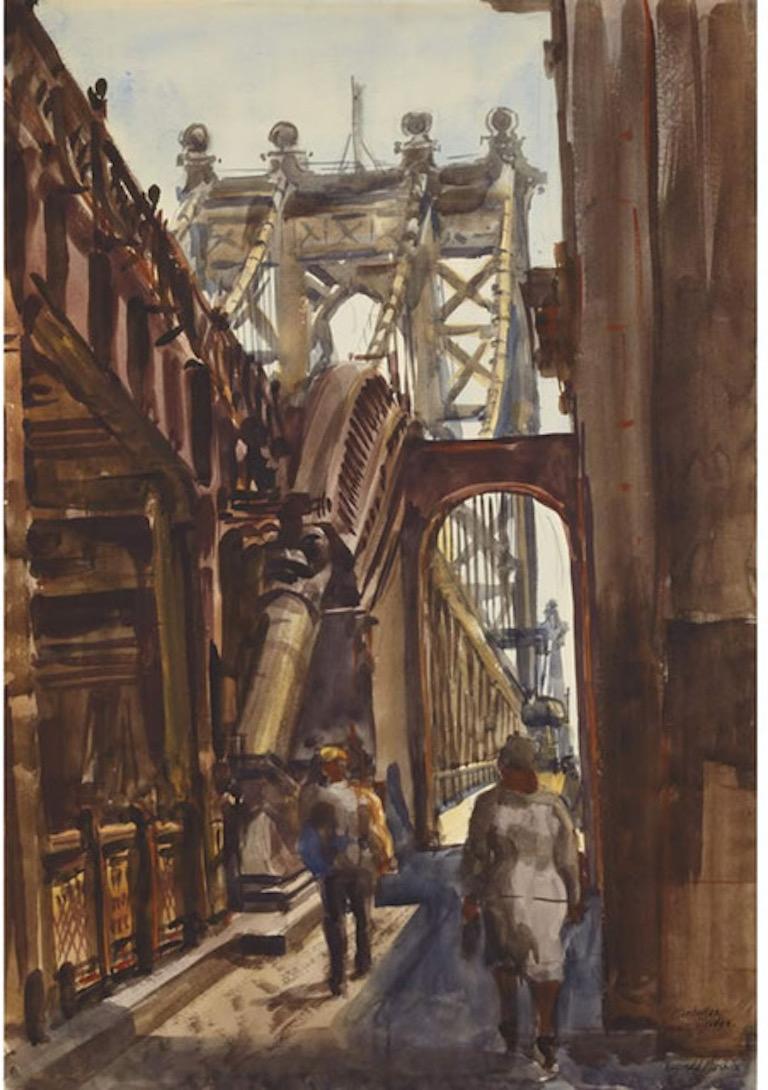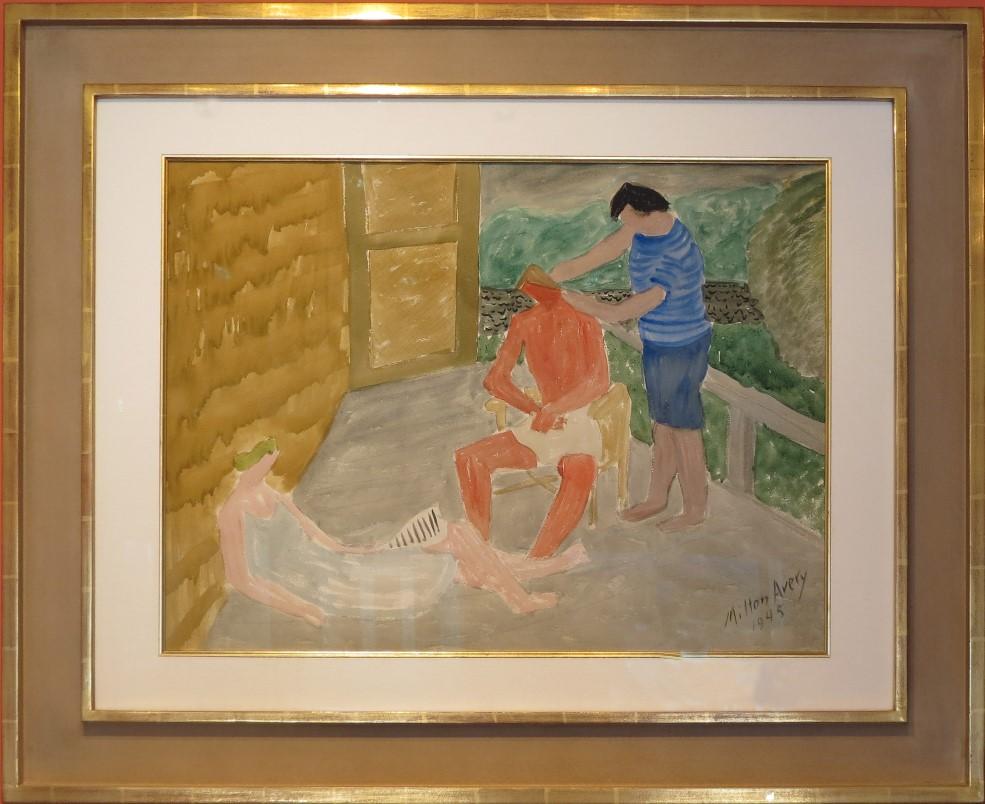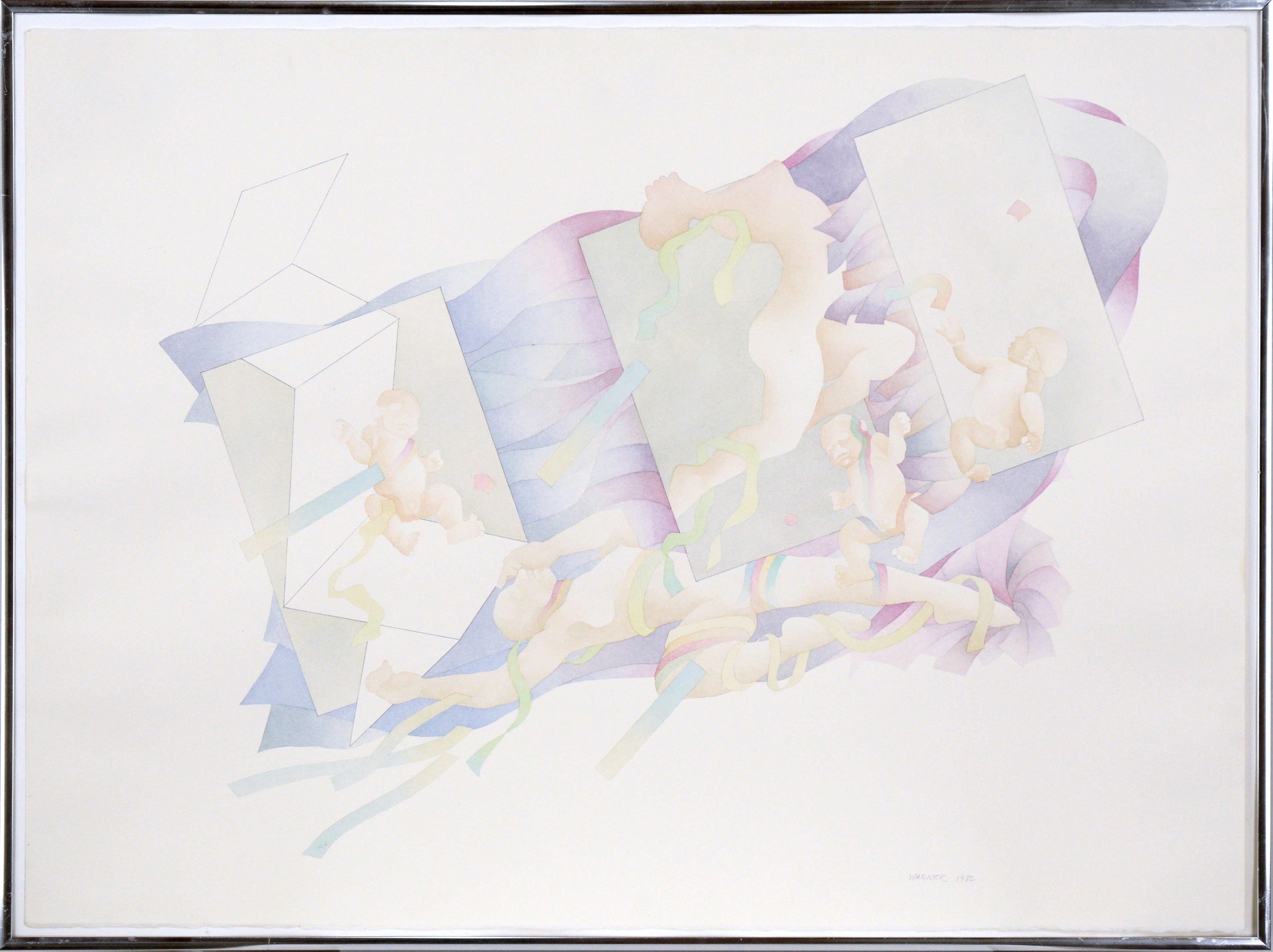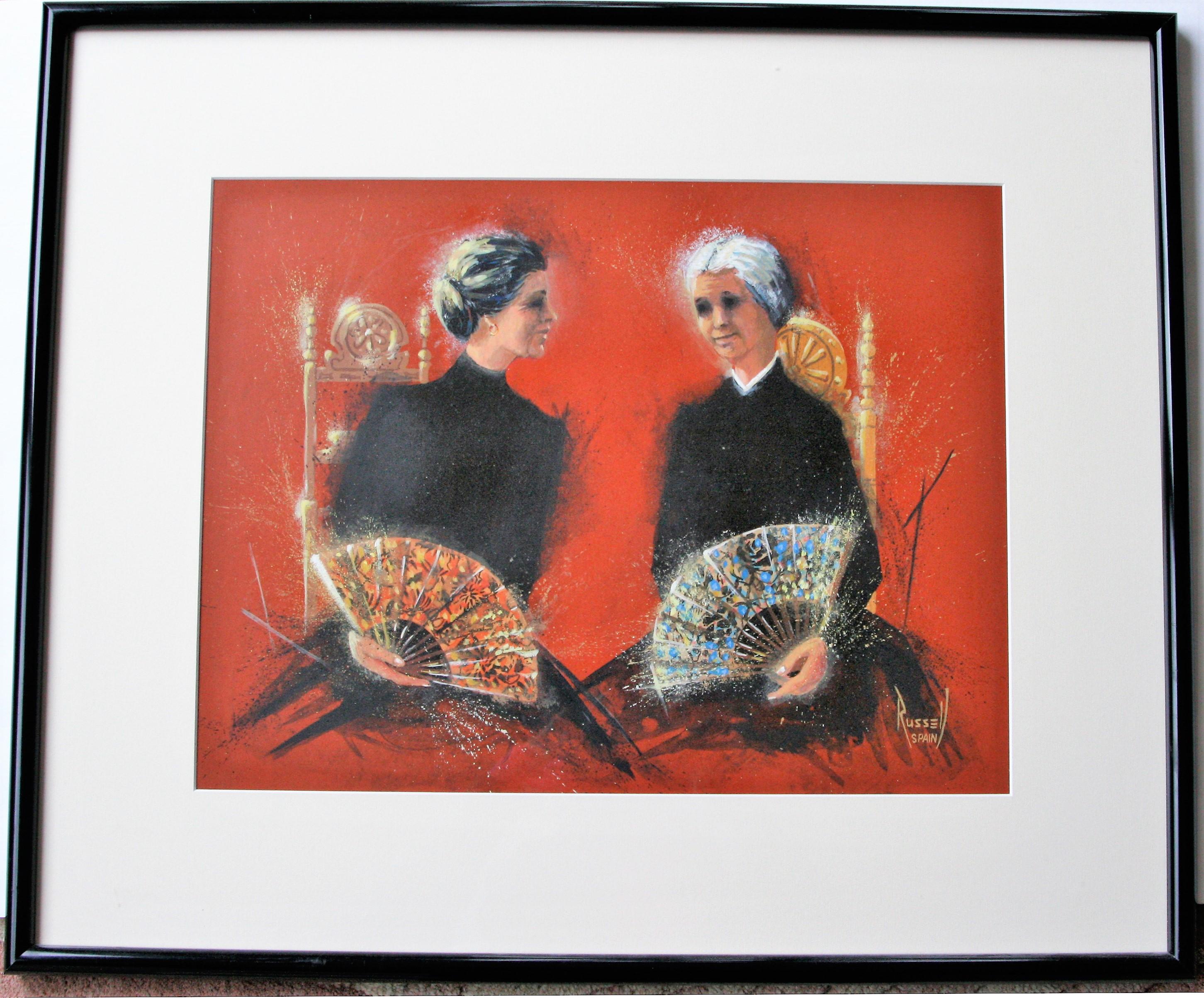Items Similar to Interior Scene with Figures
Want more images or videos?
Request additional images or videos from the seller
1 of 9
Louis SchankerInterior Scene with Figuresc. 1930s
c. 1930s
About the Item
Interior Scene with Figures
Ink and watercolor on paper, c. 1930's
Signed with the Estate stamp lower center
Condition: Loss upper right corner; two small tears lower margin
Colors very fresh and vibrant
Provenance: Jem Hom Gallery, Washington, D.C.
Martin Dimanond Fine Arts, NYC (?)
Louis Schanker (1903–1981)[1] was an American abstract artist.
"He grew up in an Orthodox Jewish environment in the Bronx, New York. His parents, Sam, a tailor, and Fannie Schanker, were of Romanian descent.[2] He had five siblings.[3] At an early age he had an interest in both art and music He took art courses at Cooper Union, The Educational Alliance and The Art Students League with Barnett Newman, Mark Rothko and Milton Avery amongst others. During this time he shared a coldwater studio with the Soyer brothers, Chaim Gross and Adolph Gottlieb. In 1920 he traveled across the country. He lived the hobo life, joined the Sparks and then Barnum and Bailey circuses, later working as a thresher in the wheat fields of the Great Plains. There are elements in his works such as the circus murals done for the Neponsit Beach Children's Hospital and the print "Man Cutting Wheat" that reflect these experiences. Around 1924 he returned to New York, leased another studio and resumed his friendships and artwork. Schanker spent 1931 and 1932 attending classes at the Académie de la Grande Chaumière, painting and traveling in Paris, Italy and Spain and returned as something of a Cubist. He had his first show in 1933 at the Contemporary Arts Gallery and first exhibited at the Whitney Museum in 1936.[4]
The Federal Government sponsored programs to assist people during the 1930s depression when there were no jobs available. Artists were included in the Public Works of Art Project and then the WPA Federal Art Project. Schanker participated in both beginning in 1933. He was an artist and supervisor in the mural and graphic arts departments. In the New York City Division he worked with many other artists including Jackson Pollock, Lee Krasner, Burgoyne Diller, Byron Browne, Milton Avery, and Stuart Davis. These were controversial times in the arts community. In 1935 he and others (Ilya Bolotowsky, Ben-Zion, Marcus Rothkowitz (aka, Mark Rothko), Adolph Gottlieb, Joseph Solman, Tschacbasov, Lou Harris, and Ralph Rosenborg) formed a group called The Ten[5] that protested the lack of support for American Abstract Artists by the Whitney Museum which concentrated on representational art. Schanker and Bolotowsky were also in the awkward position of having their works being shown in the museum's 1936 Annual exhibit at the same time that they were protesting. Another group, founded in 1936, of which he was a founding member, the American Abstract Artists, (AAA) arose to promote and foster public understanding of abstract art.[4]
Schanker's "Abstraction with Musical Instruments"
Schanker was a radical among radicals. His "conglomerations of color-patches, among other things", wrote the sympathetic art critic Emily Genauer in 1935, "are bound to alienate no small part of the gallery-going public." However, the work proved popular in the New York art scene.
By 1937, even the often hostile New York Times art critic Edward Alden Jewell softened to the artist. When speaking of Schanker's major WPA mural at the municipal building studios of WNYC in New York, Jewell noted that Schanker had "a touch of lyric feeling". In 1938, Art News declared that "Louis Schanker's delightful Street Scene From My Window calls forth admiration for its delicacy of color and kaleidoscopic forms in plane geometry."
A decade later Schanker wrote:
Though much of my work is generally classified as abstract, all of my work develops from natural forms. I have great respect for the forms of nature and an inherent need to express myself in relation to those forms.
Schanker moved into teaching, first at the New School for Social Research and then, from 1949 until his retirement, at Bard College. The January 1955 Life Magazine article "Comeback of an Art", describes him as "one of the earliest U.S.woodcut artists to do abstractions, Schanker since has trained or influenced a generation of talented younger artists."[6]
He was one of the major printmakers of the 1930s. He continued to be an active part of the New York art scene with many group and solo exhibitions including two shows (1943 and 1974,) at the Brooklyn Museum and a 1978 retrospective at the Associated American Artists. Just a few blocks from the hospital where he died in 1981 the Martin Diamond Gallery was holding a major show of his oils, sculpture and prints and his work was on exhibit at the Whitney Museum of American Art.
By all accounts a delightful man, Schanker was suspect to some because of his joie de vivre. According to Mercury Gallery owner, Sidney Schectman, who was showing the works of the Ten from 1937–39, Rothko was by all reports a very serious person. He did not have many friends. "I know he liked Schanker. I once talked to him about him, but he told me that Schanker was a playboy of some sort even then, but a great painter and a great wood block [painter] ... you know, painted, the greatest. "But I don't know where he's going to go," he would say because he thought he was frivolous. And that's the kind of person Rothko was, terribly, terribly serious."[7]
Schanker's has remained popular and there is still continuing interest in his works. In 1989, summing up Schanker's career for a book on American abstraction, Virginia Mecklenburg wrote of "an animated expressionism that aims at a fundamental emotional structure".
He married stage actress and singer Libby Holman on December 27, 1960. She was a fierce champion of social causes and was an early supporter of civil rights. It was due to her generosity that in 1959 the young Dr. Martin Luther King Jr. and his wife Coretta, were able to travel to India to study firsthand the non-violent techniques espoused by Gandhi. King was always grateful to Libby for giving him this pivotal opportunity. King, Coretta and Libby and Schanker would remain lifelong friends."
Courtesy of Wikipedia
- Creator:Louis Schanker (1903-1981, American)
- Creation Year:c. 1930s
- Dimensions:Height: 19.75 in (50.17 cm)Width: 25.5 in (64.77 cm)
- Medium:
- Movement & Style:
- Period:
- Condition:Original.
- Gallery Location:Fairlawn, OH
- Reference Number:
About the Seller
5.0
Recognized Seller
These prestigious sellers are industry leaders and represent the highest echelon for item quality and design.
Platinum Seller
These expertly vetted sellers are 1stDibs' most experienced sellers and are rated highest by our customers.
Established in 1978
1stDibs seller since 2013
713 sales on 1stDibs
Typical response time: 1 hour
Associations
International Fine Print Dealers Association
- ShippingRetrieving quote...Ships From: Fairlawn , OH
- Return PolicyA return for this item may be initiated within 10 days of delivery.
More From This SellerView All
- Quick ChangeBy Honore GuilbeauLocated in Fairlawn, OHQuick Change Watercolor on paper, 1930-1931 Signed lower right: Honore Guilbeau Illustrated in American Art Review, August 2014, page 84 in an article by Dr. M...Category
1930s American Modern Figurative Drawings and Watercolors
MaterialsWatercolor
- Bull engaging the muleta (Bull Fight)By Robert HallowellLocated in Fairlawn, OHBull engaging the muleta (Bull Fight) Signed with the Estate stamp lower left (See photo) Provenance: Estate of the Artist Marbella Gallery Inc., NYC Refer...Category
Mid-20th Century American Modern Animal Drawings and Watercolors
MaterialsWatercolor
- Two Women and a Child on the Beach at ProvincetownBy Charles DemuthLocated in Fairlawn, OHTwo Women and a Child on the Beach at Provincetown Unsigned. Watercolor on paper, c. 1934 A beautiful Provincetown beach scene, included in the catalogue raisonne. Please see Babcoc...Category
1930s American Modern Drawings and Watercolor Paintings
MaterialsWatercolor
- Bull Ring Brass - Mexico CityBy Stephen LongstreetLocated in Fairlawn, OHBull Ring Brass - Mexico City Watercolor, pen and ink on paper, 1955 Signed in ink, dated and titled in pencil (see photos) Condition: 1'' repaired tear left edge, along with other minor tears. Tape stains from previous matting visible in the four corners Image/Sheet size: 19 3/8 x 15 5/8 inches Provenance: Acquired directly from the Artist Joseph M. Erdelac, Cleveland, friend and patron of Longstreet Stephen Longstreet (1907-2002) The artist’s own grandchildren attempt to fathom the real life and nature of Stephen Longstreet, prolific author, artist, screenplay writer, and jazz aficionado. Born Chauncy Weiner (sometimes spelled Wiener) in New York City in 1907, Longstreet reinvented himself on a regular basis. Changing his name first to “Henry,” then “Henri,” he started his career as a commercial artist for a department store. In various public biographies he claimed to have studied in New York, London, and Paris, and said he was a student of cartoonist Ralph Barton (1891-1931). Facts that can be documented are that he was art editor for Golfer and Sportsman magazines, and was a contributor to various other magazines including The New Yorker, Saturday Evening Post, Colliers, Life, and Hooey, among others. He wrote sketches for NBC radio and the Rudy Vallee Show. In the 1930s, Longstreet worked and wrote under the names Thomas Burton, David Ormsbee, and Paul Haggard...Category
1950s American Modern Figurative Drawings and Watercolors
MaterialsIndia Ink, Watercolor, Pen
- Lonly (Lonely)By Stephen LongstreetLocated in Fairlawn, OHSigned lower right Provenance: Joseph M. Erdelac, Cleveland, OH Possibly deaccessed from the Columbus Museum of Art THOMAS FRENCH FINE ART, LLC Stephen Longstreet (1907-2002) A...Category
20th Century American Modern Figurative Drawings and Watercolors
MaterialsWatercolor
- Girl in ProfileBy William SommerLocated in Fairlawn, OHGirl in Profile Lithographic crayon and watercolor on thin wove paper, c. 1930 Signed twice in pencil (see photos) Provenance: Estate of the Artist Edward Somme...Category
1930s American Modern Figurative Drawings and Watercolors
MaterialsWatercolor
You May Also Like
- "Manhattan Bridge" NYC American Scene Modernism Watercolor WPA Urban RealismBy Reginald MarshLocated in New York, NYReginald Marsh "Manhattan Bridge" NYC American Scene Modernism Watercolor WPA Urban Realism, 20 x 14 inches. Watercolor and pencil on paper, 1938. Signed...Category
1930s American Modern Landscape Drawings and Watercolors
MaterialsPaper, Watercolor, Pencil
- "Country Haircut"By Milton AveryLocated in Lambertville, NJJim’s of Lambertville Fine Art Gallery is proud to offer this piece by Milton Avery (1885 – 1965). Milton Avery was a prominent Modernist painter whose work combined abstraction and...Category
1940s American Modern Figurative Drawings and Watercolors
MaterialsWatercolor, Gouache, Paper
- "Bathers" American Scene Social Realism 20th Century Modernism Ashcan FauvismBy Charles DemuthLocated in New York, NY"Bathers" American Scene Social Realism 20th Century Modernism Ashcan Fauvism Charles Demuth (1883-1935) "Bathers" 10 1/2 x 8 1/4 inches watercolor on paper, c. 1930 Signed lower le...Category
1930s American Modern Figurative Drawings and Watercolors
MaterialsPaper, Watercolor
- "Woman in Fancy Costume Estate #752, " Watercolor & Graphite signed by SpicuzzaBy Sylvia SpicuzzaLocated in Milwaukee, WI"Woman In Fancy Costume Estate #752" is a watercolor and graphite signed by Sylvia Spicuzza. A woman stands with arms stretched out. The lady is wearing a red and white stripped outf...Category
1950s American Modern Figurative Drawings and Watercolors
MaterialsGraphite, Watercolor
- "Transition, Series 1, No. 4" - Watercolor Figurative IllustrationLocated in Soquel, CASubtly shaded abstract figurative illustration by Elsa Warnick (American, 1942-2013). Two adult and three baby figures are rendered with subtle tan shading, against an abstract background with geometric shapes and swirling ribbons. One of the two adult figures is laying down, while the other appears to be jumping or dancing. Notable is the skillful use of negative space to balance the composition. Signed and dated "Warnick 1982" in the lower right corner. Signed, titled, and dated with materials information on verso. Presented in a silver aluminum frame. Frame size: 23.5"H x 31.25"W Paper size: 23.25"H x 31"W Elsa Warnick (American, 1942-2013) was born and raised in Tacoma, Washington. She moved to Portland to attend the Reed College/Museum Art School joint five year program. Warnick went on to create many works of art as well as teach art and illustration. She is mostly known for her watercolor paintings, including the illustration of several children's books. Some of her pieces are held in the Portland Art Museum’s collection. Selected Exhibitions: 1974: University Center Gallery, Willamette University - Salem, OR 1978: Mayer Gallery...Category
1980s American Modern Figurative Drawings and Watercolors
MaterialsPaper, Watercolor, Pencil
- Two Dueñas.By Donn RussellLocated in Storrs, CTTwo Dueñas. c. 1960. Watercolor and gouache. 13 x 17. Signed and annotated 'SPAIN' lower right. Housed in a 21 x 25-inch black wood frame. Donn Russell is one of Nantucket Island's...Category
1950s American Modern Portrait Drawings and Watercolors
MaterialsWatercolor, Gouache





